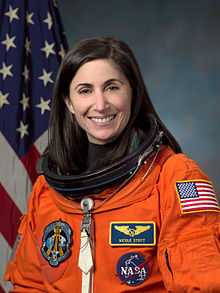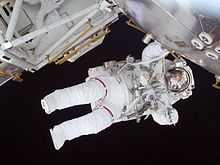Nicole Stott
| Nicole P. Stott | |
|---|---|
 | |
| NASA Astronaut | |
| Nationality | American |
| Status | Active |
| Born |
November 19, 1962 Albany, New York |
| Other occupation | Engineer |
| Time in space | 103d 05h 49m [1] |
| Selection | 2000 NASA Group |
| Missions | STS-128, Expedition 20, Expedition 21, STS-129, STS-133 |
| Mission insignia |
|
Nicole Marie Passonno Stott is an American engineer and a NASA astronaut. She served as a Flight Engineer on ISS Expedition 20 and Expedition 21 and was a Mission Specialist on STS-128.[2] In 2011, She flew a second time as a Mission Specialist on STS-133.
Early life and education
Stott was born in Albany, New York and resides in Clearwater, Florida. She attended St. Petersburg College studying aviation administration, graduated with a B.S. degree from Embry-Riddle Aeronautical University in 1987, and received her M.S. degree in Engineering Management from the University of Central Florida in 1992. Nicole Stott began her career in 1987 as a structural design engineer with Pratt & Whitney Government Engines in West Palm Beach, Florida. She spent a year with the Advanced Engines Group performing structural analyses of advanced jet engine component designs. Stott is an instrument rated private pilot.
NASA career

In 1988, Stott joined NASA at the Kennedy Space Center (KSC), Florida as an Operations Engineer in the Orbiter Processing Facility (OPF). After six months, she was detailed to the Director of Shuttle Processing as part of a two-person team tasked with assessing the overall efficiency of Shuttle processing flows, and implementing tools for measuring the effectiveness of improvements. She was the NASA KSC Lead for a joint Ames/KSC software project to develop intelligent scheduling tools. The Ground Processing Scheduling System (GPSS) was developed as the technology demonstrator for this project. GPSS was a success at KSC, and also a commercial success that is part of the PeopleSoft suite of software products. During her time at KSC, Stott also held a variety of positions within NASA Shuttle Processing, including Vehicle Operations Engineer; NASA Convoy Commander; Shuttle Flow Director for Endeavour; and Orbiter Project Engineer for Columbia. During her last two years at KSC, she was a member of the Space Station Hardware Integration Office and relocated to Huntington Beach, California where she served as the NASA Project Lead for the ISS truss elements under construction at the Boeing Space Station facility. In 1998, she joined the Johnson Space Center (JSC) team in Houston, Texas as a member of the NASA Aircraft Operations Division, where she served as a Flight Simulation Engineer (FSE) on the Shuttle Training Aircraft (STA).

Selected as a mission specialist by NASA in July 2000, Stott reported for astronaut candidate training in August 2000. Following the completion of two years of training and evaluation, she was assigned technical duties in the Astronaut Office Station Operations Branch, where she performed crew evaluations of station payloads. She also worked as a support astronaut and CAPCOM for the ISS Expedition 10 crew. In April 2006, she was a crew member on the NEEMO 9 mission (NASA Extreme Environment Mission Operations) where she lived and worked with a six-person crew for 18 days on the Aquarius undersea research habitat.[3] Stott was previously assigned to Expedition 20 and Expedition 21. She was launched to the International Space Station with the crew of STS-128, participating in the first spacewalk of that mission,[4] and returned on STS-129, thus becoming the last Expedition crew-member to return to Earth via the space shuttle. Stott completed her second spaceflight on STS-133, the penultimate scheduled flight of the space shuttle.[5][6]
First live tweetup from space
On October 21, 2009, Stott and her Expedition 21 crewmate, Jeff Williams, participated in the first NASA Tweetup from the station with members of the public gathered at NASA Headquarters in Washington, D.C.[7] This involved the first live Twitter connection for the astronauts.[8] Previously, astronauts on board the Space Shuttle or ISS had sent the messages they desired to send as tweets down to Mission Control which then posted them via the Internet to Twitter.[9]
References
![]() This article incorporates public domain material from websites or documents of the National Aeronautics and Space Administration.
This article incorporates public domain material from websites or documents of the National Aeronautics and Space Administration.
- ↑ "Astronauts and Cosmonauts (sorted by "Time in Space")". Spacefacts. January 21, 2012. Retrieved January 26, 2012.
- ↑ National Aeronautics and Space Administration (October 23, 2010). "NASA - Expedition 20". NASA. Retrieved January 26, 2012.
- ↑ NASA (2006). "NASA's Undersea Crew is Heads Above Water". NASA. Retrieved September 23, 2011.
- ↑ NASA (August 2009). "STS-128 Mission Summary" (PDF). NASA. Retrieved January 26, 2012.
- ↑ NASA Newsroom (March 3, 2009). "NASA - NASA Announces Change for Return of Station Crew Members". NASA. Retrieved January 26, 2012.
- ↑ "collectSPACE - news - "NASA shuffles shuttle schedule: Endeavour to fly after Discovery for final planned flight"". collectSPACE.com. April 26, 2010. Retrieved January 26, 2012.
- ↑ Cioffi, Carla (October 21, 2009). "20091021 NASA Live Tweetup Event with International Space Station - a set on Flickr". NASA. Retrieved January 26, 2012.
- ↑ Yembrick, John (October 1, 2009). "NASA Hosts Long-Distance Tweetup with Astronauts on Space Station". NASA. Retrieved October 20, 2009.
- ↑ Horowitz, Etan (May 22, 2009). "The great debate over Astro Mike's 'tweets from space'". The Orlando Sentinel. Retrieved October 2, 2009.
External links
| Wikimedia Commons has media related to Nicole Stott. |
| ||||||||||||||||